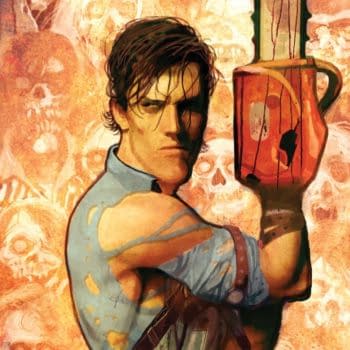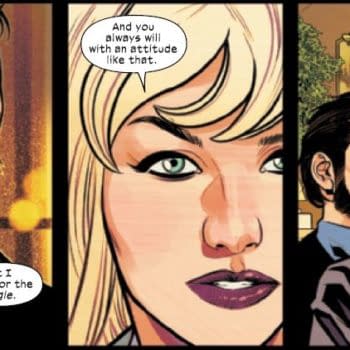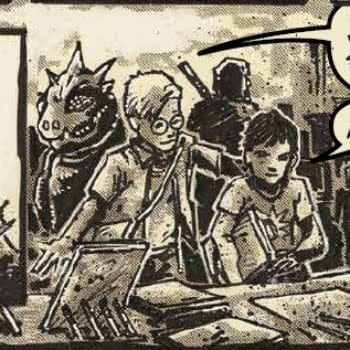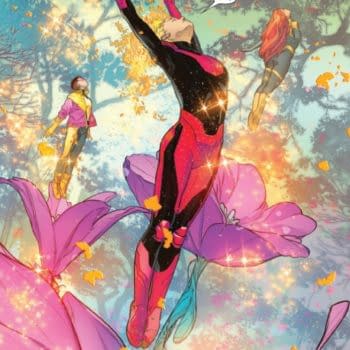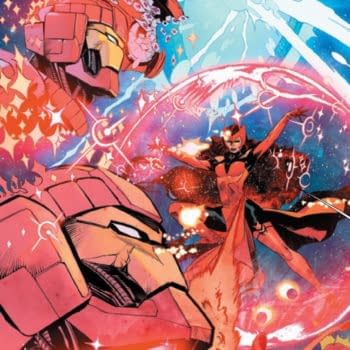Posted in: Recent Updates | Tagged:
Jim Shooter's Affidavit Against DC Comics Over Flex Mentallo

The allegation was that this was an infringement of trademark and copyright of the famous Charles Atlas adverts on the backs of comics, though it seemed to me at the time that this was a clear example of parody and satire, aspects of the adverts being given a psycho-magical interpretation. Jim Shooter however, didn't agree.
The judge dismissed the case against DC Comics, but they had expressed an intention not to use the character again. Although Flex Mentallo later appeared in the Doom Patrol trade paperback reprints, the Flex Mentallo series has never been reprinted and the character has never been reused.
But what I hadn't read before was ex-Marvel Comics Editor-In-Chief, Jim Shooter's involvement, who appeared as an expert witness for Charles Atlas.
Shooter stated that Grant Morrison and DC Comics were trading on the likeness and resemblance of Flex Mentallo to Charles Atlas so that the character would be popular. And that everyone Jim spoke to in the industry assumed that DC had licensed the Charles Atlas rights, or that Charles Atlas must have gone bankrupt.
But it's his description of Grant Morrison's work that is most entertaining.
The writer of Flex Mentallo, Grant Morrison, is a highly regarded comic book writer known for his somewhat dark and surreal style. He tends to present the fantastic elements of the comic book universe in an ironically gritty "realistic" way. His stories and characters often explore the ramifications of a universe where at any moment someone may swoop out of the sky wearing a costume, or a sorcerer might cast a spell.
Morrison uses the ironic juxtaposition of fantasy and reality to dramatize and drive home story points – slapping readers in the face with the weirdness of conceits that they've been conditioned to accept without question as givens, and making them see them in a new, harsh (and somewhat horrifying) light.
Morrison is not, and not considered to be, a writer of parody. The Flex Mentallo storyline is standard surreal comic book adventure, consistent with Morrison's portrayal of the Doom Patrol and other standard non-satirical, non-parodic super hero characters. Flex Mentallo is not a parody.
Which does kind of ignore work such as Dare, The New Adventures Of Hitler or indeed Animal Man, where parody and satire come hand in hand, skipping and jumping down the lane going "la la la". And indeed Doom Patrol, which once featured a fight scene with one brain in a jar being thrown at another. If that's not a parody of traditional superhero beat-em-ups, well, then Stan Lee is a banana.
Jim Shooter's attached biography is also intriguing, stating amongst other achievements, creating Happy Meals-style toys for burger chains, including writing copy for promotional materials in 1992 and a screenplay treatment for a sci-fi movie, The Omega Point.
Here's that report and affidavit in full;
—————————————————————————————-
United States District Court, S.D. New York.
CHARLES ATLAS, LTD., Plaintiff,
v.
DC COMICS, INC., Defendant.
No. 99 Civ. 4389 (NRB).
March 22, 2000.
Affidavit
Name of Expert: James Shooter
Area of Expertise: Art, Entertainment & Media >> Print Media
Case Type: Intellectual Property >> Trademark/Trade Name
Case Type: Unfair Competition & Business Practices >> Trade Secrets
Jurisdiction: S.D.N.Y.
Representing: PlaintiffTABLE
JAMES SHOOTER, being duly sworn, deposes and says:
1. I am the former Editor in Chief of Marvel Comics, a long-time freelance comics writer and creator, and lecturer on comics and visual media. Annexed hereto as Exhibit A is a copy of my resume. I am fully familiar with all the facts and circumstances described herein, including the works of the DC Comics at issue, and the works of Grant Morrison, the writer of Flex Mentallo. I make this affidavit in opposition to the motion for summary judgment or partial summary judgment made by defendant DC Comics, Inc. ("DC," or "defendant").THE IMPORTANCE OF COMIC CHARACTER ORIGINS AND CONTINUITY
2. Comic book characters are generally part of a "universe," that is, a publisher's stories generally take place in the same context and relate to each other. In other words, each story is a part of the larger, overall story of the world in which the individual stories occur. It is, in fact, all one, big, on-going story.
3. Indeed, the DC comic characters, including the Vertigo super hero characters, all live in the "DC Universe." (Flex Mentallo has been featured in Who's Who in the DC Universe, clearly positioning him as a member of the standard DC pantheon of super characters. See annexed Exhibit B, which is a copy of the cover and two internal pages of DC's 1992 Who's Who).
4. Editors and writers are obliged to pay a great deal of attention to "continuity," i.e., does the story make sense within the context of the universe, and is it consistent with the history of the universe as it has been established in previous stories.
5. For example, if aliens are invading the Earth in a Green Lantern story, the writer and editor must account for why Superman doesn't step in to "save the day," since he presumably would be aware of the invasion and equally concerned. For another example, if in one issue a character learns Batman's secret identity, that character must know it in subsequent issues, or the writer and editor must come up with a credible explanation for his amnesia.
6. DC Comics has even published special series, such as Crisis on Infinite Earths, and Zero Hour, with gigantic storylines extending into issues of each of their characters' comic magazines (i.e., Superman, Doom Patrol, Batman, etc.). These "crossovers" are often done for the express purpose of tidying up the "universe" and fixing problems of continuity.
7. In short, the histories and origins of characters are extremely important to readers of comic books, who are extraordinarily "continuity conscious." Similarly, building a "collective work" is of extreme importance to comic book writers and editors. Details of the origins and pasts of comic characters are absolutely essential elements of the character in each appearance of the comic character.
8. New readers quickly learn to expect continuity, and often strive to learn the history that they may have missed. The lore is available in a number of ways. Comics, unlike virtually any other periodical (with the exception, possibly, of Playboy), remain available and on sale as back issues in collector shops and online. DC Comics and other publishers frequently reissue previously published stories in trade paperback and hardback editions. Collector shops serve almost as clubhouses – places where fans get together to discuss stories and characters.
9. There are also endless resources online – sites dedicated to various titles, chats with creators, message boards for communications between and among fans and occasionally professionals.
10. Further, there are frequent "conventions" held around the country where avid fans congregate, where publishers such as DC Comics set up booths and dress models in the garb of their superheroes, where back issues of comics are sold, etc.11. In sum, the DC Universe (and every other comic book universe) is a work in progress, continuing to be built with each new issue, fan newsletter, convention, online message board, etc. Each story is a glimpse of the overall story of the world where all DC characters reside. The tapestry being created constantly is viewed not only stitch-by-stitch, but as a unified whole, with every story and character carefully related to each other, and deliberately relating back to previous issues and storylines.
THE DIFFICULTY OF INTRODUCING NEW CHARACTERS
12. It is difficult for a comic publisher to introduce a new character into a well-entrenched pantheon of comic book characters in the publisher's "universe" (up against the likes of Superman and Wonder Woman). Most of the DC comic book characters that have enjoyed success as films, TV shows, and licensing properties were created in the '30's and '40's. Relatively few all-new characters catch on and become popular enough even to be quickly featured in their own series.
13. For that reason (and others), many comic book characters introduced by writers, or by writers at the behest of editors, are characters with established equity or cachet of some kind. Editors and writers often "recycle" old comic characters that are currently dormant but were once popular and may still retain some audience awareness.
14. For example, the current Green Lantern and Flash are based upon – and in fact are revamped revampings of '40's characters.
15. In 1987, Superman artist John Byrne, for instance, literally swiped (copied) the cover of the first Superman issue published in 1938, for a modern-era revamping of Superman (this was all within the DC universe so not actionable). Literal "swipes," and other utilizations of established names, characters and images are clearly and deliberately meant to take advantage and trade upon the equity and recognizability of the original character.
16. Applied to this case, it is clear to me that, with generations of comic book readers fully familiar with Charles Atlas from the Atlas advertisements appearing in virtually every DC comic book, DC Comics intended to trade upon this recognizability in order to establish the new character of Flex Mentallo, who, it goes almost without saying, is Charles Atlas only slightly revamped — that is, renamed and boorish.
17. I believe that comic book readers generally recognized Flex Mentallo as a blatant swiping of the character and artistic style portrayed in the Atlas trademark advertisements. Several comic book readers who I asked about Flex Mentallo told me that they assumed that DC Comics had somehow acquired the right to use the Charles Atlas trademark character and advertisement, or that it was free for the taking because "the company [Atlas] went out of business or something."
THE FLEX MENTALLO CHARACTER AND STORYLINES ARE NOT PARODY
18. The writer of Flex Mentallo, Grant Morrison, is a highly regarded comic book writer known for his somewhat dark and surreal style. He tends to present the fantastic elements of the comic book universe in an ironically gritty "realistic" way. His stories and characters often explore the ramifications of a universe where at any moment someone may swoop out of the sky wearing a costume, or a sorcerer might cast a spell.
19. Morrison uses the ironic juxtaposition of fantasy and reality to dramatize and drive home story points – slapping readers in the face with the weirdness of conceits that they've been conditioned to accept without question as givens, and making them see them in a new, harsh (and somewhat horrifying) light.
20. Morrison is not, and not considered to be, a writer of parody. The Flex Mentallo storyline is standard surreal comic book adventure, consistent with Morrison's portrayal of the Doom Patrol and other standard non-satirical, non-parodic super hero characters. Flex Mentallo is not a parody.
21. Accordingly, defendant's motion should be denied.
JAMES C. SHOOTER
Major Accomplishments1965- 1970
Writer, layout artist and cover designer for Superman, Superboy, Supergirl, Action Comics and other DC comics. I was thirteen when I started writing comics professionally – a world record that still stands. I was trained as a writer, editor and manager of creative organizations by chief editor and executive VP Mort Weisinger, who was responsible not only for overseeing the comics, but also for the development of Superman, Batman and other DC properties for radio, film, stage, television, toys and licensing. He was also among the most prolific and successful writers of non-fiction magazine articles and books of his era. Among many other things, he taught me that writing is architecture as well as art, and that effective communication is the key to non-fiction and fiction writing.1970- 1976
Freelance writer, art director and illustrator for Lando-Bishopric Advertising. I conceived, designed, wrote and occasionally illustrated ads for a number of accounts, most notably US Steel on their "Where's Joe?" and "We're Involved" campaigns. I also worked as a consultant to Foote-Cone Belding/Hoenig, San Francisco, on the Levi's Jeans account.1976- 1978
Editor, Marvel Comics. Among my many duties was plotting the Spider-Man syndicated strip, working closely with Stan Lee, principal creator and founder of Marvel.1978- 1987
Editor in chief and VP, Marvel Comics. I supervised Marvel's entire creative effort, managing an editorial and production staff of seventy-five, and directed the work of over two hundred freelance creators. I was also Marvel's creative representative to domestic and international licensees. I collaborated with toy companies, including Mattel and Hasbro on the development of toys lines such as G.I. JOE, TRANSFORMERS and MARVEL SUPER HEROES/SECRET WARS; and I worked with film and television producers, including Dino DeLaurentis, George Romero, Michael Winner and Casablanca Record and Film works, to develop Marvel properties.1987
Lectured on comics and visual media at the Institute of Contemporary Arts in London.
Consulted on the development of the Spider-Man balloon for the Macy's Parade; created the design for and oversaw the development of the Marvel Comics float. Wrote "Spider-Man and the Night of Doom" a live action children's arena show for TM Productions, optioned by Radio City Music Hall and MCA Universal.1988
With Chase, N.A. as my financial advisor and Shenkman Capital Management, Inc. as equity partner, attempted leveraged buyout of Marvel Comics. Our $81 million bid was second behind that of Ronald O. Perelman's Andrews Group.
Wrote business plan for CineVentures Entertainment, a film financing and film development company.1988- 1989
Consulted with The Walt Disney Company on the development of an in-house comics publishing division, Disney Adventures Magazine and several animated television series.1989
Wrote After the Dinosaurs, the Story of Prehistoric Mammals and Man, and Baby Animals on the Farm for Golden Books.1989 – 1992
Founded Voyager Communications Inc., publishers of VALIANT comics. I developed over two dozen properties for comics and exploitation in other media, including "Turok, Dinosaur Hunter," which became a runaway hit video game. I designed all VALIANT ads and wrote all promotional, advertising and solicitation copy. Voyager also marketed its creative services (mostly mine) to commercial clients. I created and illustrated packaging and displays for Tiger Toys' LAND OF THE LOST toy line, and created premium/advertising "custom comics" for Kraft General Foods, MetLife, Kentucky Fried Chicken, Nintendo of Japan, MCA Records and others. Voyager, originally capitalized at $3 million, was sold to Acclaim Entertainment in 1993 for $65 million.1992
Consulted with Equity Marketing, Inc., creating promotional premiums ("Happy Meal" toys) for Arby's, Burger King, Wendy's and others. I also wrote in-pack copy and sales materials.1992 – 1994
Founded Enlightened Entertainment Partners, LP, publishers of DEFIANT comics. Developed ten properties for comics and other exploitation. As with Voyager, I designed all ads and wrote all promotional, advertising and solicitation copy. I also wrote copy for several sets of trading cards based on our characters. The DEFIANT properties were acquired by Golden Books Family Entertainment in 1996.1994- 1997
Founded Broadway Comics in partnership with Broadway Video Entertainment, whose parent, Broadway Video, Inc., was owned by Lorne Michaels. I developed eleven properties for comics, film, television and licensing. Again, I designed all ads and wrote all promotional, advertising and solicitation copy. Broadway Video Entertainment, including Broadway Comics, was sold to Golden Books Family Entertainment in late 1996.1997
Freelance "concept doctor," hired by Saban Entertainment to redevelop an animation and toy property.1998
Development work. I've done development work for Fox LightFlash Films on two science fiction film projects. I also developed an entertainment/educational property for Pantone Color Systems, Inc.
Original screen treatment. I wrote "The Omega Point," a treatment for a big budget science fiction film, currently optioned to Plan Z Productions.
Technical writing. I wrote business plans and promotional materials for Inner Circle Guaranty, Inc., a film financing company.
Freelance copywriting. I've written various advertising and promotional copy for Display Technologies, Inc., Ericksen Advertising and Design, The Concept Shop and others.1999 to present
Freelance writing. I'm writing UNITY 2000, a comic book series for Acclaim Entertainment and doing development work and technical writing for Global Internet Services, Inc.
Throughout my career, I've written hundreds of articles for trade magazines, introductions for books, columns for my own publications, editorials, endorsements, letters of recommendation, testimonials, memorials, proposals, presentations, critiques, lectures, synopses and speeches. I can ghost styles. I have a thousand and one uses around the home and office.
Samples and references available upon request.






